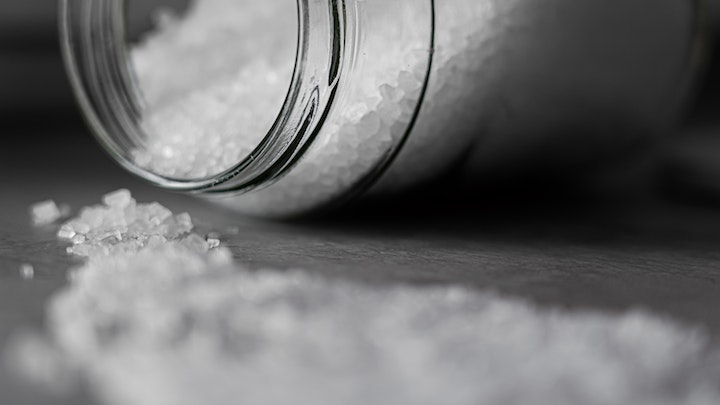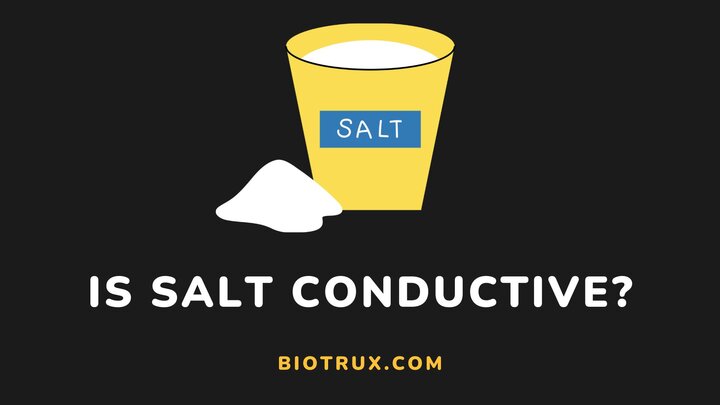Salts are ionic compounds and do not conduct electricity in a solid state. This is why the table salt (sodium chloride) in your kitchen is non-conductive or capable of getting you electrocuted.
The ions in this compound will, however, become conductive or very mobile when melted or dissolved in an appropriate solvent. Hence, melted table salt or salt water is considered a good conductor.
Moving forward in this guide, you will learn how salt acts as both conductors and insulators, its electrical conductivity and resistivity, real-life applications and if it conducts heat.
Structure and Properties of Salt

- Salt or sodium chloride crystals have a cubic appearance.
- Salt is white and odorless.
- They are brittle, hard, and crystalline.
- Salt comprises negatively charged ions (OH-) and positively charged ions (H+).
- Electrostatic attraction occurs between these oppositely charged ions.
- All sodium (Na), potassium (K), and ammonium (NH4+) are soluble in water.
Is Salt a Conductor or an Insulator?
Salt can be a conductor and an insulator depending on its state. In a solid state, salt maintains a chemical inertia responsible for making its ions immobile. Immobile or trapped ions mean salt cannot conduct electricity.
However, when salt dissolves in an appropriate solvent, the ions at rest (inertia) become very mobile and free. This state of restlessness makes it possible for salt to conduct electricity.
For example: when sodium chloride (NaCl) dissolves in water, positive ions (anions) and negative ions (cations) separate. At this point, these ions carry charges that conduct electricity.
How Does Salt Water Conduct Electricity?
Electrical conductivity can only occur in melted salt or salt water. The process follows the principle of attraction between opposite charges and can be confirmed using electrolysis.
When salt comes in contact with water, the hydrogen (in water) serves as a positive terminal and attracts chloride (with negative ions). Oxygen, on the other hand, acts as a negative terminal and attracts sodium (with positive ions).
To form a stable ionic compound, sodium has to donate an electron to chlorine to become more positively charged. These actions lead to the formation of Hydrochloric acid (HCL) and sodium hydroxide (NaOH) as seen in the equation below:
2NaCl (aq) + 2H2O (l) —> 2 NaOH–(aq) + H2(g) + Cl2(g)
The hydrogen and chlorine gas that make hydrochloric acid (HCL) eventually escape into the atmosphere.
Is Salt Water More Conductive than Pure Water?
Under normal circumstances, pure water is not a better conductor than salt water. This is because pure water has a resistance of over 900,000 ohms.
On the other hand, when salt is introduced into pure water, it becomes charged due to the presence of sodium and chlorine. Also, the resistance of the solution reduces to about 80,000 ohms and conducts electricity better.
Is Salt Water More Conductive than a Sugar Solution?
Sugar contains carbon, hydrogen, and oxygen held together by covalent bonds (sharing of electrons between two or more atoms). When dissolved in water, it is a poor conductor of electricity because its electrons are very stable.
Salt water, on the other hand, consists of sodium and chlorine electrolytes. Its ionic bond supports the radical movement of electrons, hence, it conducts electricity better than sugar solutions.
Uses of Salt
Salt has a variety of real-life applications as conductors and insulators.
- Molten salt or salt water helps in the production of non-ferrous metals like aluminum and titanium.
- They help in stripping metals or other materials of impurities
- Salt plays a major role in flavoring, tanning, bleaching, and soap-making.
Does Salt Conduct Heat?
Solid salt does not conduct heat. Melted salt or salt water, however, is a good conductor of heat. This is because ions or charge carriers within the compound readily absorb heat.
Salt requires a melting temperature of about 1473.4°F (800.8°C) to transform into liquid from a solid state. To transform into vapor, it requires exposure to a temperature of about 2669°F (1465°C).
These high boiling and melting points are indicators that salt is a great conductor of heat.
FAQs
How much salt does it take to make water conductive?
Ideally, 1 gram of salt is enough to make 300 ml of water conductive.
Which salt conducts electricity best?
Table salt or normal salt dissolved in water is the most conductive.
Salt conductivity depends on the concentration of ions (higher concentration means greater conductivity).
Is iodized salt more conductive?
Adding iodine to a salt solution will not make it more conductive.
This is because iodine is almost insoluble in water and does not conduct electricity in any form.
Conclusion
As you can see, the state of any salt determines its conductivity. When salt is dry or in a solid state, its ions are imprisoned.
However, when you introduce water, these ions become very agile and active. One way to confirm this is by placing an electrode in a bowl of salt water.
To prevent electrocution, do not touch the salt solution with your naked hand after the introduction of an electrode.
I hope you found this article helpful. Perhaps you would like to know if water conducts electricity in the absence of salt, please see does pure water conduct electricity.
Thank you for reading.
